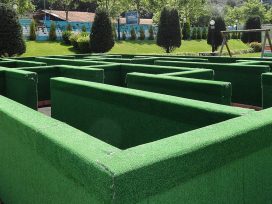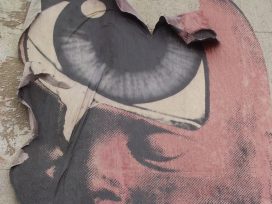Why did Sigmund Freud choose to use a “divan” or a Turkish couch for psychoanalysis puzzled many of his patients and colleagues. “What have the Turkish (designs, stripes…) got to do with you?” they often asked him.
Ever since “the couch” has been an inseparable part of the theatrics of analysis. It has been used as a tool in advancing the treatment process. For most psychoanalytic patients, it offers an opportunity to relax, undistracted by the therapist’s visible presence, and comfortably report thoughts, and feelings as they arise. One patient once explained :
“My inner self melted as soon as I placed myself on that old, tattered couch. As my body sank in the soft cotton, my soul collapsed with it, tears filled my eyes. It would not have been the same if I was sitting on a chair. Anything that supports my back strengthens my resistance.”
How did Freud develop the idea of “divan” as a part of psychoanalysis staging? The story of the divan’s therapeutic powers is an interesting journey into his creative mind as well as to the Europe of his time. The research conducted by Freud expert Peter Swales that revealed Freud’s secret affair with his sister-in-law, also unveils that the famed psychotherapist might have had an envy to have it just like the Turks of his time. As pictured in the orientalist paintings of the time, the “divan” was the main figure in a harem, covered with carpet and cushions, usually with a half-naked odalisque lying on it.
One of Freud’s early carpets was a gift from Moritz Freud, a distant relative, who later married his sister Mitzi. Moritz, a merchant in Salonica in western Macedonia, then a Turkish province and a centre of the white slave trade, acquired the carpet in the Turkish port city of Izmir. At that time, the stereotypical view of Turkish males was that of being great connoisseurs of feminine beauty who were addicted to all sorts of erotic experience – a strong notion among the Judeo-Christian population of Europe. So one could speculate that when presenting the carpet, Moritz told his brother-in-law about the legendary tale of how slave women were wrapped in them to be presented to Pashas for pleasure.
Naturally, these tales of the sexual habits and polygamous lifestyle of Turks who threatened Vienna for many decades were a subject that aroused great curiosity amongst Europeans. The same curiosity led Freud on a trip to Bosnia Herzegovina in order to observe those customs in their original habitat, as he would later report to various colleagues. And it was no coincidence that this voyage would take place in his most sexually troubled time, during which his mind was occupied with his sister-in-law, Minna. That is how the “divan” became a vehicle of confession for the west.
Freud’s first use of the divan in his practice in Vienna started with Moritz’s gift. He later extended his carpet and cushion collection, covering the floors and walls as well as the sofa with them. This was the time, Swales noted in his article, that he developed his theory of Death and Sexuality, during which he also had an affair with his sister-in-law.
Swales explains how Freud travelled to Trebinje near Ragusa, Bosnia Herzegovina, during the summer of 1898. He wrote his observations to his colleague Wilhelm Fliess in Viyana using the term “the various peculiarities of the Turks.” Several years earlier, back in Vienna, he became acquainted with a younger colleague, Alois Pick, who, some years previous to that, had served as a military physician at the local Austrian garrison, and later had told Freud stories about the general character and sensibility of the many so-called “Turks” still living locally. Swales reports that in
“Pick’s expert testimony, typically the Turks of Bosnia-Herzegovina showed an admirable resignation to the vicissitudes of fate, whereas, in curious contrast, they tended to confer upon sexual pleasures with a truly supreme importance. Thus, advised that a family member was suffering a terminal illness, a local paterfamilias might respond to the physician, with the utmost deference: ‘Sir what is there to be said? I know that if he could be saved, then you would help him’; whereas, once upon a time, by contrast, a Turk had remarked in respect to sexual pleasures: ‘Surely, Sir you must know that when that comes to an end, then life has no more value.'”
Swales also explains at the time
“a widespread misconception in the Occident was that every Turkish male was a polygamist, although in fact this was true only of a rich and privileged minority. All the same, throughout the Levant and into the Orient as far to the east as India and China, the haremlik (seraglio-zanana-andarün-purdah) system was a commonplace. This generally entailed that a part of abode, strictly secluded with its own entrance and often a restricted courtyard and garden was occupied only by the women and children of a household – in Turkey, by up to four wives in addition, quite often, to concubines – odalisques – slaves, purchased by a pasha, or sometimes presented to him as gifts – who in many cases were supervised and protected from male intruders by eunuchs…”
Swales claims that in this state of mind Freud adopted a well-known Turkish aphorism “A wife’s sister is sweeter than honey.” Over time, he writes,
“Freud would create for himself a de facto harem – Martha, Minna, Emma, Fanny, Marie, Helene, Lou, Anna et. al. – with the royal couch as its very organizing principle.”
Freud states in his 1898 essay that the “topic” of Death and Sexual Pleasures was connected with “a certain piece of news” – meaning the suicide of a sexually disturbed patient. Swales describes the 1898 essay as a personal confession. He also points out that in a footnote, Freud declared that “the heart as a sick organ itself plays a role in the thoughts.” Freud in 1894 suffered cardiac symptoms, and consulted Breuer on that account. However, by 1898, he no longer believed that he had a cardiac condition. Swales concludes that “the ambiguity of the very notion, ‘the heart as a sick organ’ serves to encode – and yet here to betray – his love and his lust for his wife’s younger sister.”
He explains this thesis as follows: “now that the altogether subjective nature of Freud’s preoccupation in summer 1898 with Death and Sexual Pleasures has been laid bare, still to be fleshed out is the very cultural matrix that stands to illuminate his fascination of that time with ‘various peculiarities of the Turks’ and, accordingly, his decision – if not his long-standing determination – to visit the small town of Trebinje. In his 1898 essay, Freud notes how his colleague Pick ‘had told me what a supremely important value these (Bosnian Turks) place on sexual pleasures’; and, in the 1901 version, he conveys the gist of this as ‘these Turks cherish sexual pleasure above all else…'”
Very likely, then Freud had discussed the whole topic of the sexuality of the Turks with Pick in a more sweeping, general way, and, in his recollection some years later, the two anecdotes about Death and Sexual Pleasures served simply to conveniently encapsulate all of what he had learned of his colleague’s observations and impressions – in which case it is plausible to think there may exist other fragments of what Freud had learned from him in yet other writings from this period.
Early in 1898 in his essay Sexuality in the Aetiology of the Neuroses, eager to cock a snook at conservative-minded colleagues like Breuer, Freud had sought to demean as mere prudery the reservations expressed by some of his peers about the manner in which, routinely, he pried into the sexual lives of his psychoneurotic patients and hence violated the sanctity of their marriages and had manoeuvred to gain a rhetorical advantage by laying bare what he perceived as being a hypocritical double-standard that obtained on the part of his critics: “Are we then living in Turkey… where the sick wife may show to the physician only her arm through a hole in the wall?”






